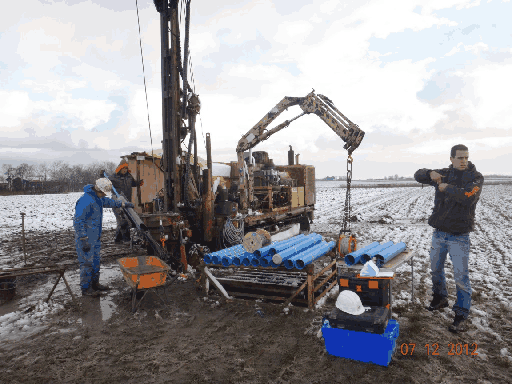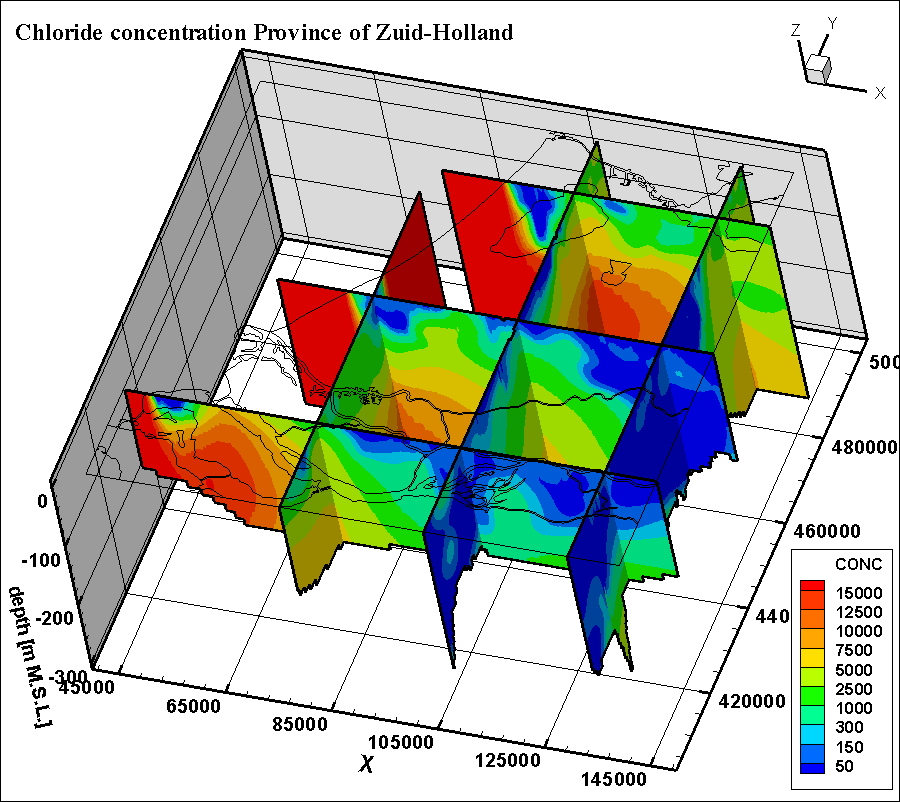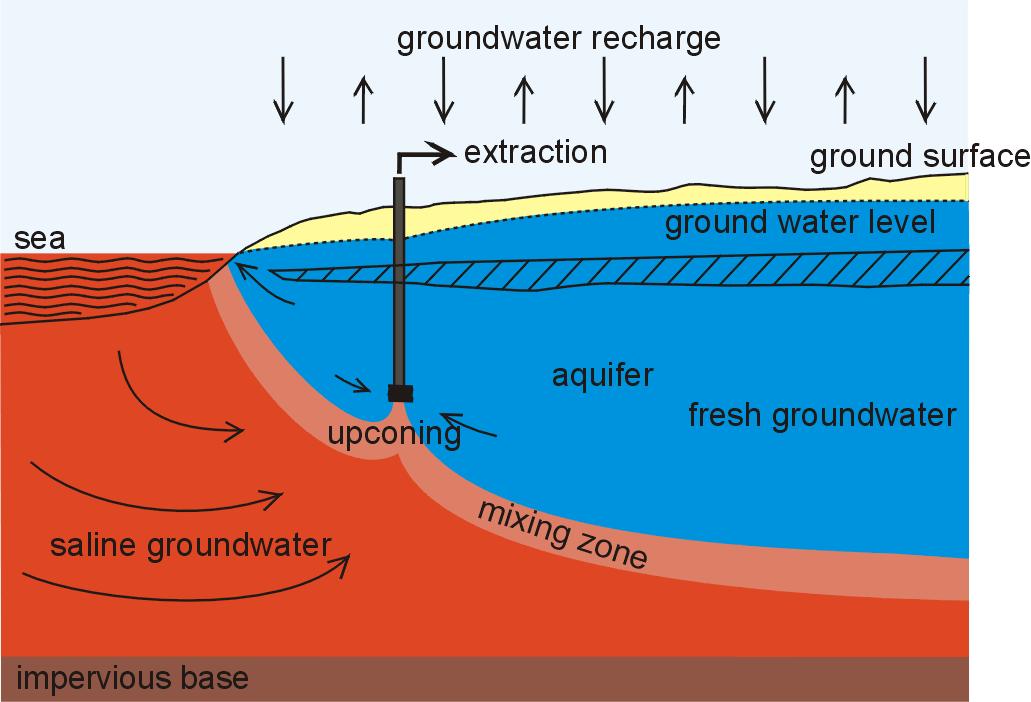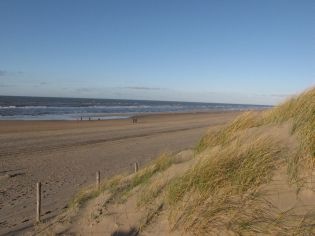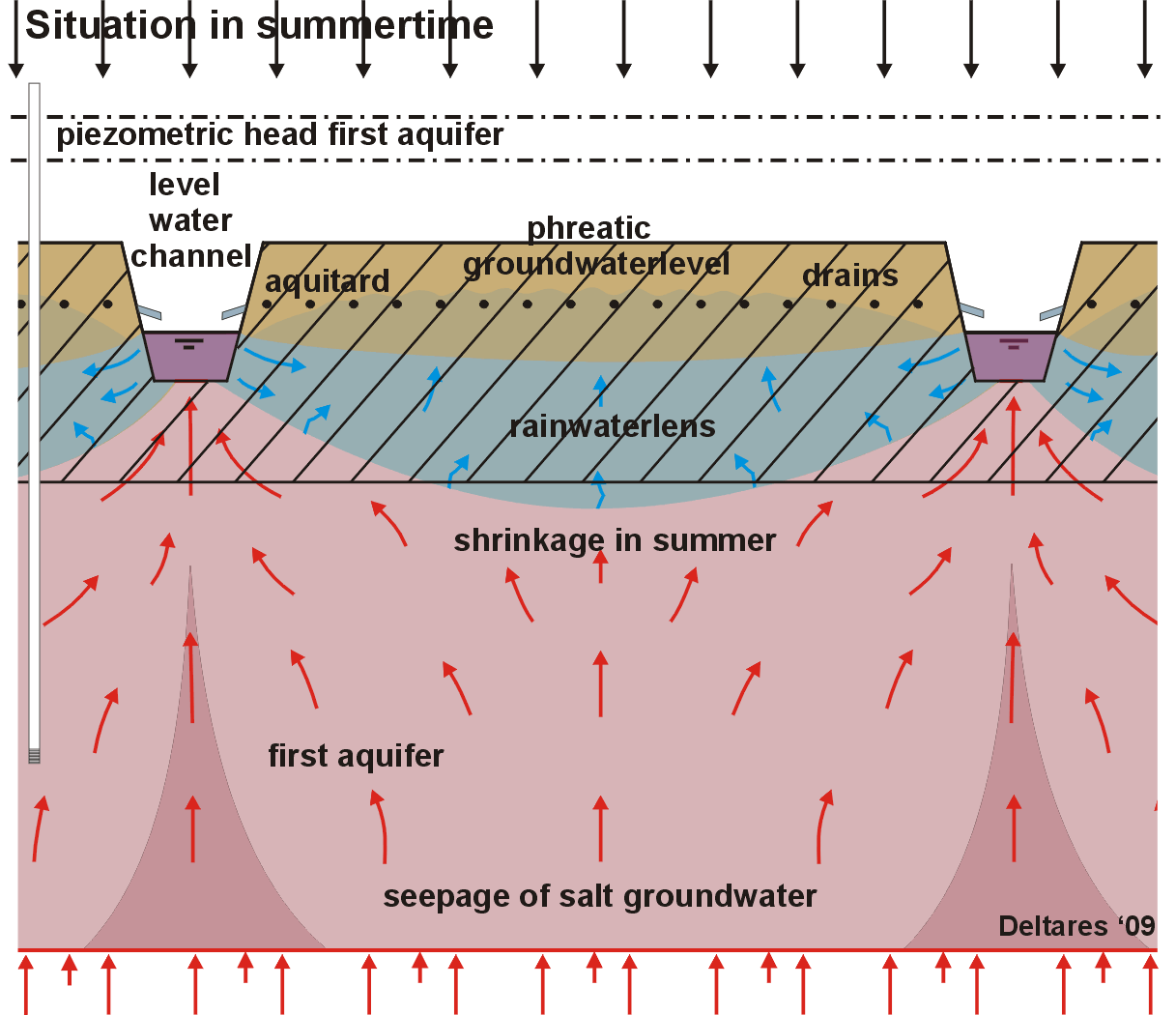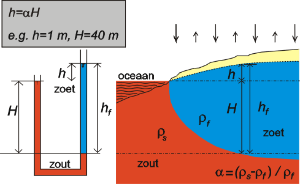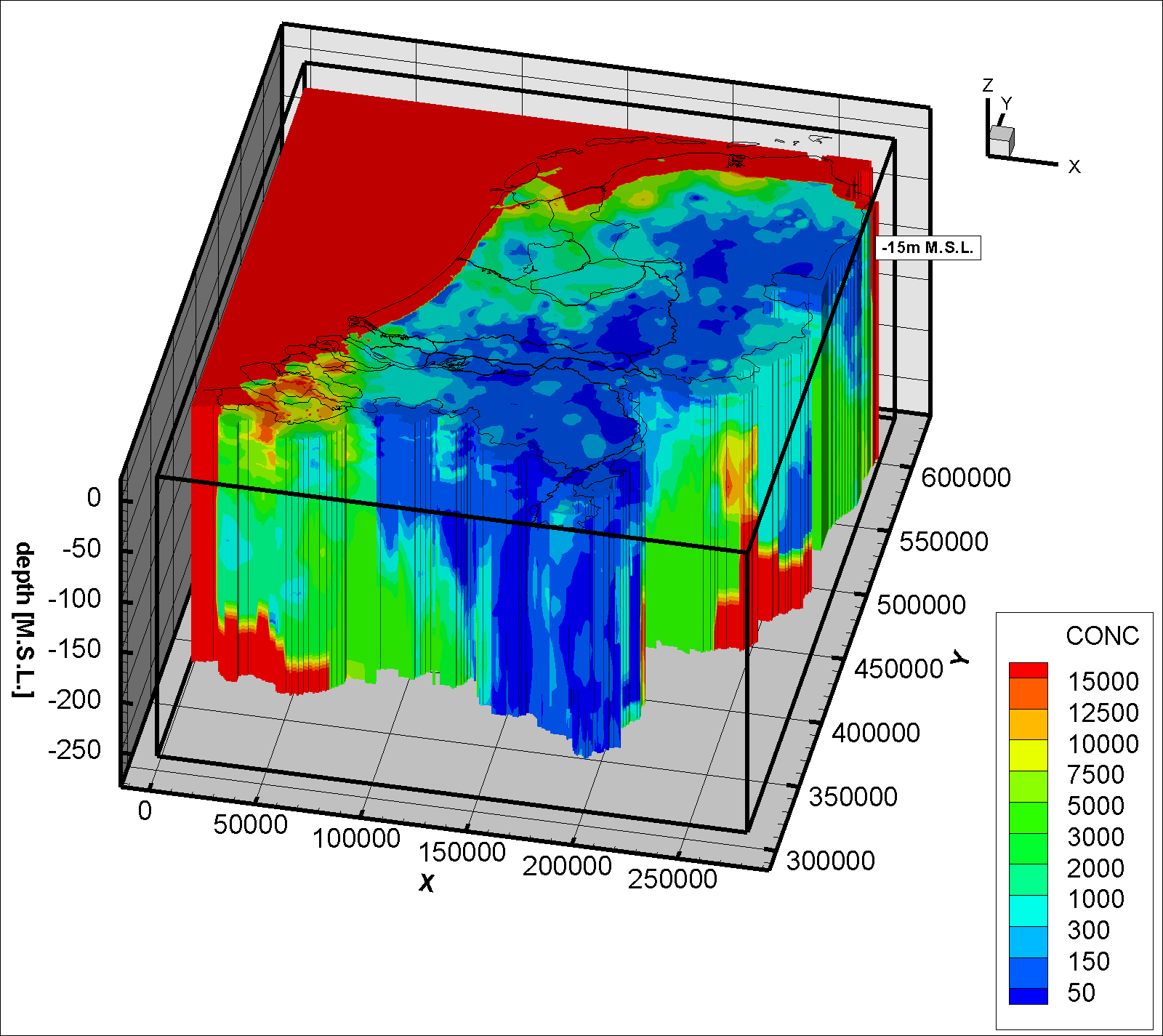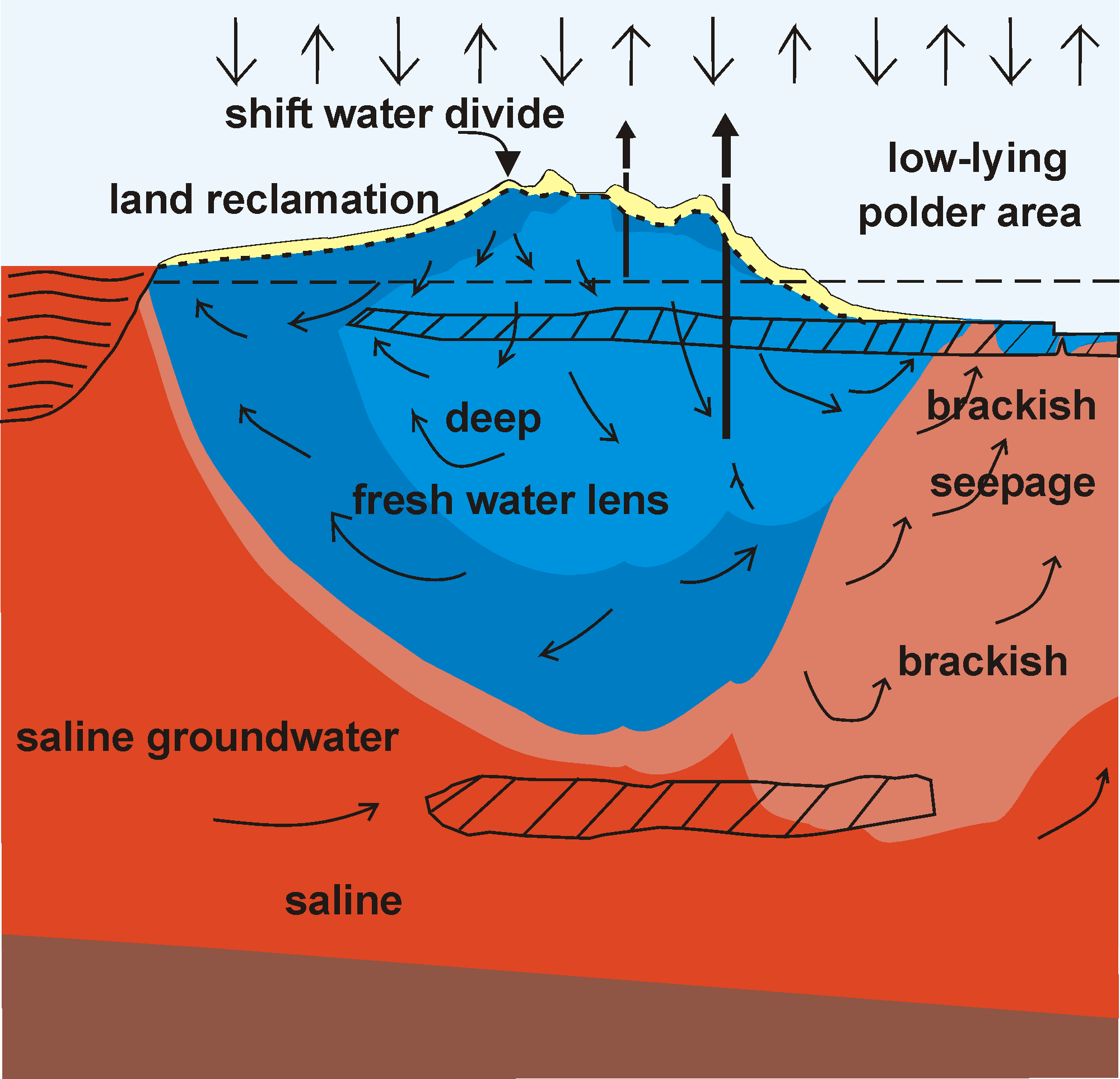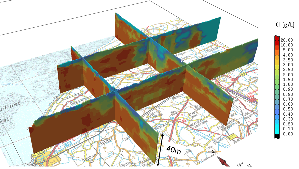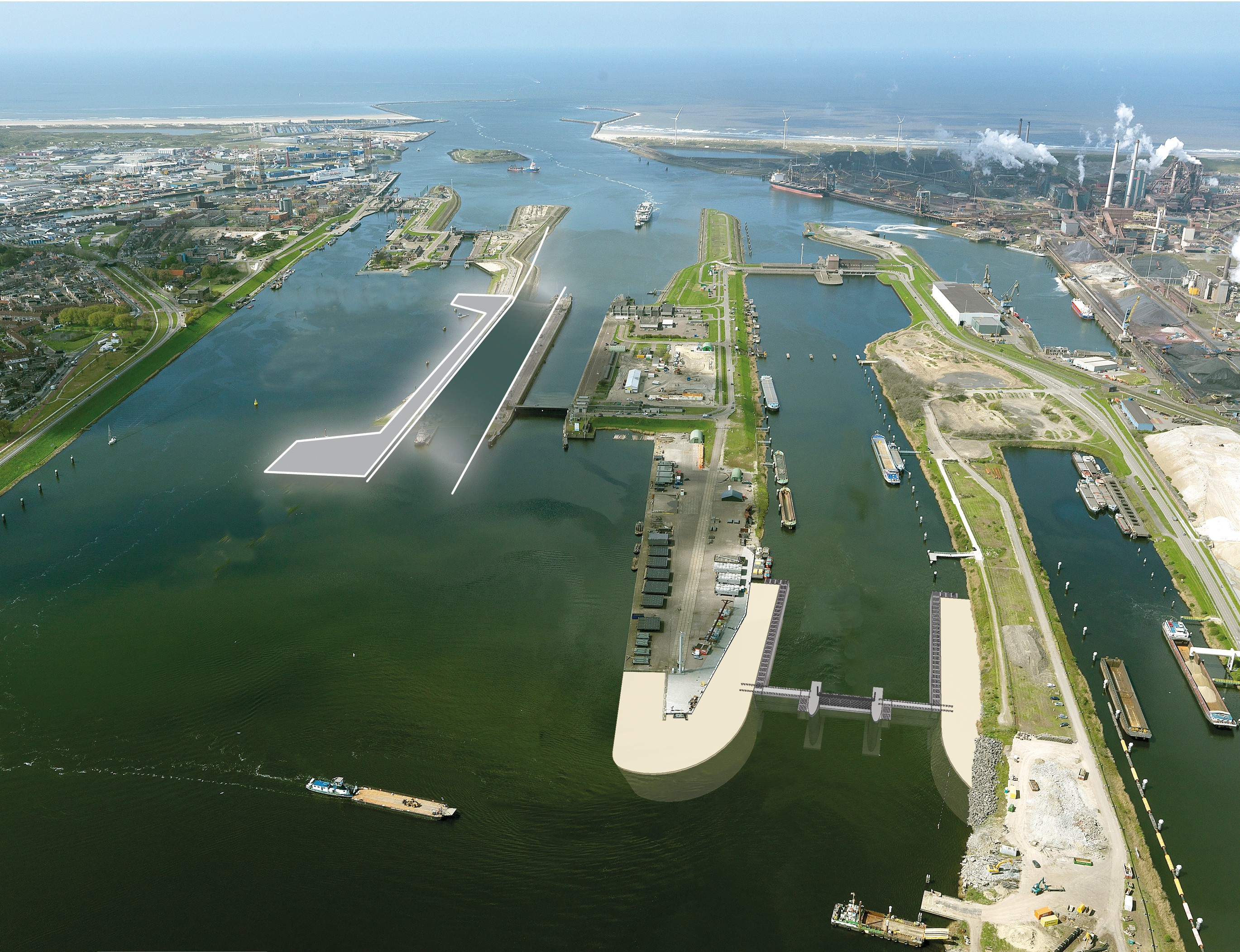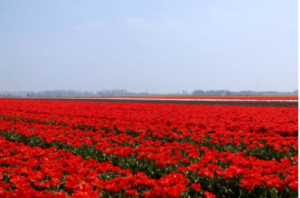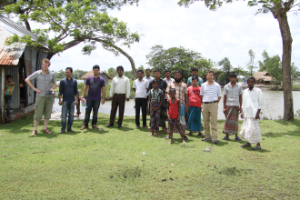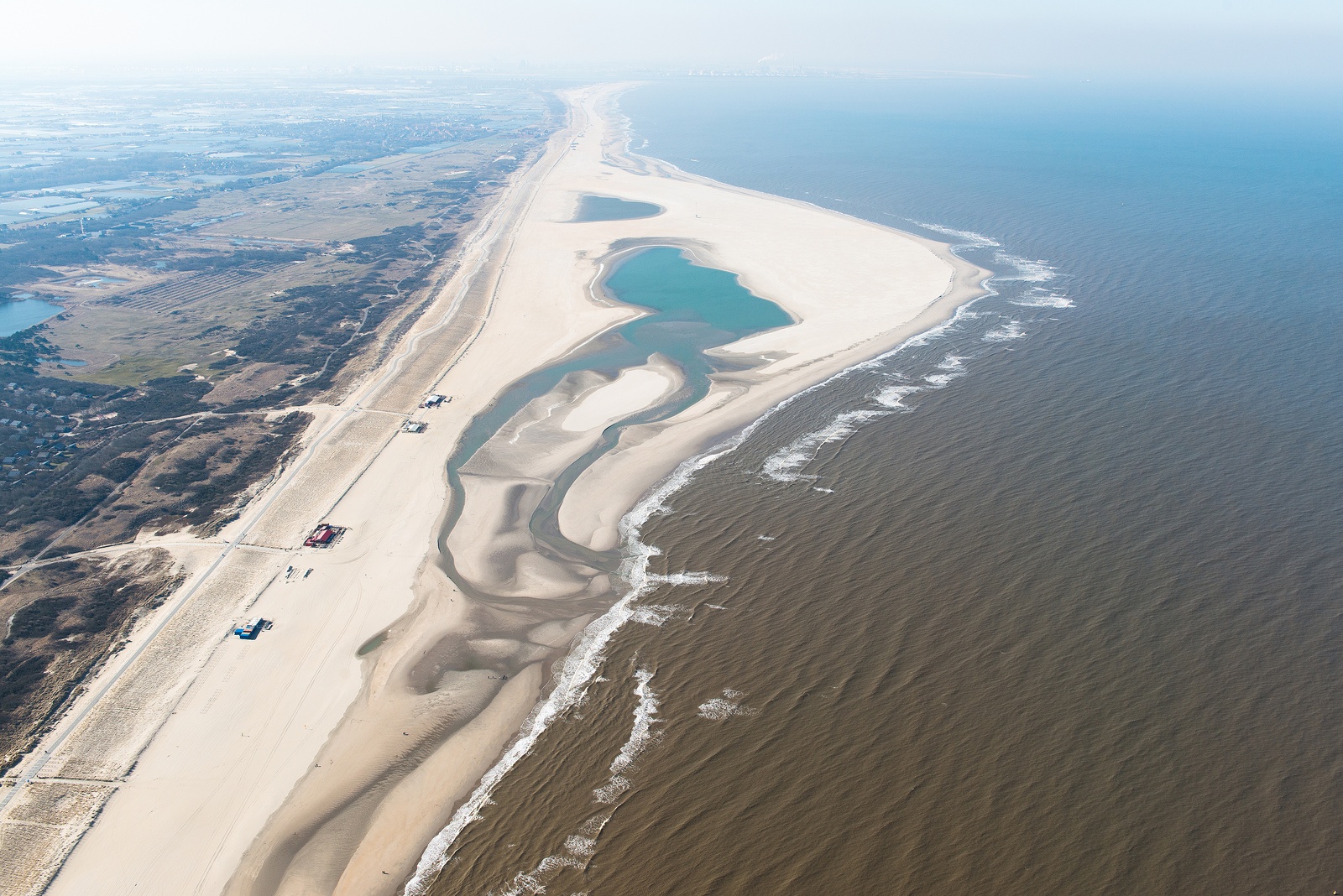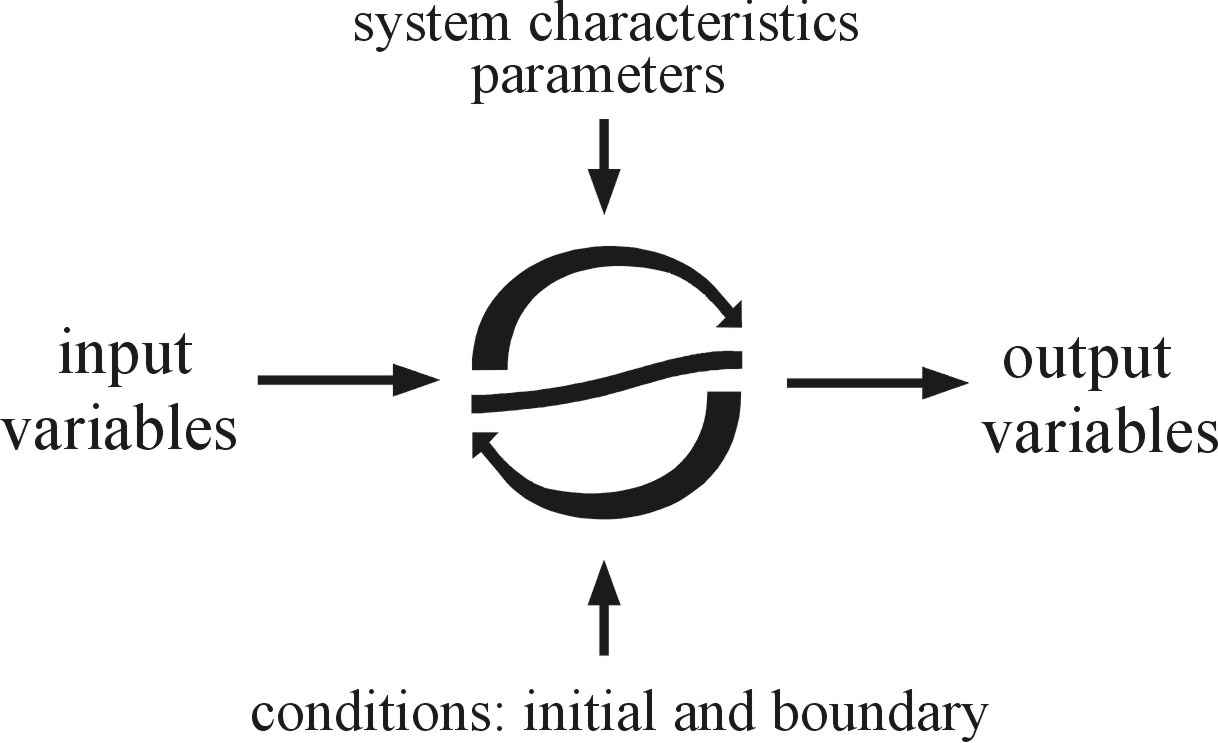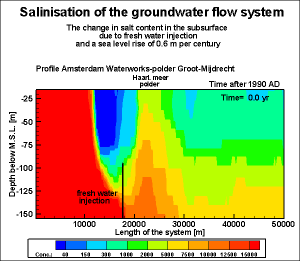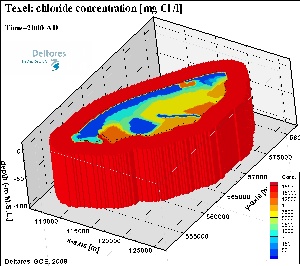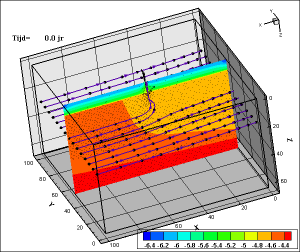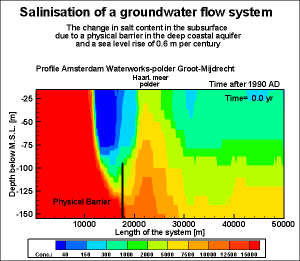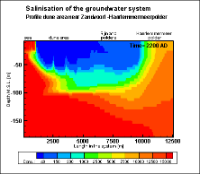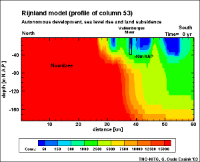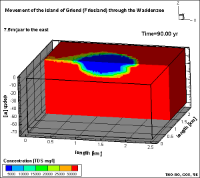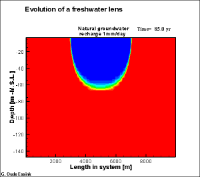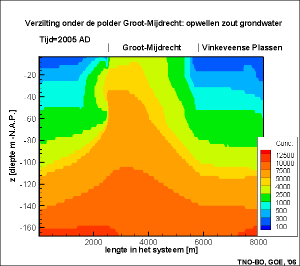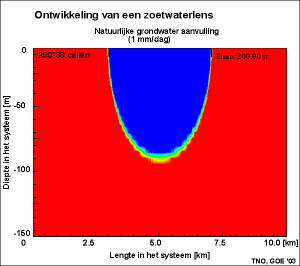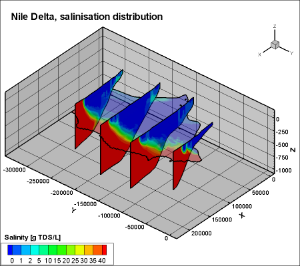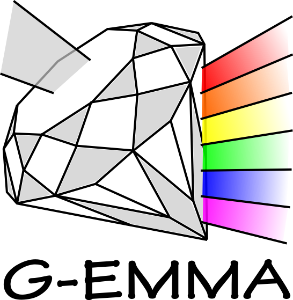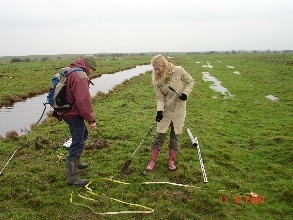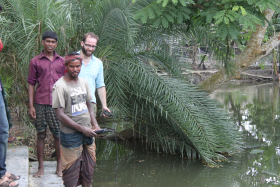On fresh-saline groundwater in deltaic areas
Wanted:
News:
http://freshsalt.deltares.nl/
OverviewProjects Dutch wiki-site |
IntroductionSalinisation causes problems for farmers, water managers and nature in many coastal areas of the world. Deltares has in-house databases, numerical modelling techniques, monitoring tools and the knowledge to thoroughly investigate salinisation issues and to implement innovative solutions for a robust climate proof fresh water supply in the coastal zone. |
Threats to fresh water resourcesPermanent groundwater drainage keeps the polder areas sustainable in a large part of The Netherlands accelerate due to the anticipated sea level rise, climate change, future land subsidence and especially due to human factors like groundwater extraction and lowering of differentiated polder water levels. The processes described here for the Dutch situation prevail in many other deltas and coastal areas. Concluding, not taking any mitigation and/or adaptation measures will lead to a world-wide increase of salinisation. |
Focus on regional and local processesDeltares researchers investigate the processes of fresh, brackish and saline groundwater on different scales. On a regional scale, the effects of climate change, land, and water use change and the combined effects of preventive measures on groundwater salinisation are studied. Other studies give answers on how groundwater concentration changes affect surface water quality. On a local scale, the dynamics of fresh rainwater lenses on saline groundwater as a result of natural or artificial recharge are studied. These lenses allow agriculture where shallow groundwater is very saline. Other research topics are preferential groundwater flow via sandy layers and boils that connect deep saline aquifers with shallow aquifers and with fresh surface water bodies. These preferential flow paths largely contribute to the salinisation of Dutch low-lying areas. Our knowledge is not specific for the Netherlands and can be applied in similar deltaic areas around the world. |
Solutions of salinisation problemsDeltares has the knowledge and expertise to study processes in combined fresh and saline groundwater systems. We develop and apply monitoring tools and techniques like the T-EC probe, EM-Slimflex and other online real-time measurement techniques. Moreover, Deltares has the modelling experience and the numeric compute codes (like MOCDENS3D/SEAWAT) at its disposal to simulate variable-density groundwater flow and coupled solute transport. Deltares is engaged in the design of specific measures needed for salinisation prevention and adaptation and for saline aquifer management. We have a long professional track record on groundwater salinisation studies built up during numerous relevant projects worldwide. |
|
Leaflet
Fresh-saline groundwater in deltaic and coastal areas
More Information
Dr.ir. Gualbert Oude Essink
T +31 (0)6 30550408
gualbert dot oudeessink at deltares dot nl
Home Projects Methods and Tools Knowledge Base Internships Publications Contact
Project |
G | S |
I | Region | Approach | Period | |
|---|---|---|---|---|---|---|---|
|
|
COASTAR is aimed at large scale freshwater supply by clever use of the subsurface. By storing freshwater underground and utilising brackish water, coastal areas can be provided with enough water to be used for drinking, irrigation and industry, now and in the future! |
X |
The Netherlands | 2016-present | |||
|
|
Freshwater Availability in the Mekong Delta (FAME) is a collaborative, multiphase project focusing on scoping, piloting and providing upscaling advice to national partners in Vietnam on the implementation of shallow Aquifer Storage and Recovery (ASR) systems. These systems could provide farm-scale solutions to address the water-quality and availability issues being faced in Ben Tre and Trah Vinh provinces in the Mekong Delta, Vietnam. |
X |
Vietnam | 2019-present | |||
|
|
Fresh water supplies cannot be taken for granted in the Province of Zeeland in the Netherlands. The main surface waters are predominantly saline. A detailed picture of the current fresh-salt |
X |
The Netherlands | Airborne EM and numerical modelling | 2010-2016 | ||
|
|
Enhancing fish migration leads to salt intrusion into fresh water reservoir. How to manage the salt water intrusion and maintain the fresh water supply to drinking water, agriculture and industry (Port of Rotterdam) is the challenge. |
X |
X |
The Netherlands | Field experiments, 3D hydrodynamic modeling | <period> | |
|
|
The Krammer locks form the boundary between the saline Eastern Scheldt and the fresh water Lake Volkerak-Zoom. The locks will have a new method of limiting salt intrusion as a result of lock-operation by by using bubble screens and flushing with fresh water. To optimise lock-operation and manage salt intrusion into the fresh water lake, a decision support system is setup. |
X |
X |
The Netherlands | Sea Lock Formulation | <period> | |
|
|
The goal of GO-FRESH (Geohydrological Opportunities Fresh Water supply) is to improve the use of existing fresh groundwater resources and create new freshwater reserves to increase regional self-sufficiency and reduce dependence on external freshwater supplies. The aims of the applied research project are: a. to investigate which measures actually ‘work’ in practice and b. to determine whether those measures are economically feasible. |
X |
The Netherlands | 2012-2017 | |||
|
|
Selective Withdrawal at IJmuiden The new shipping lock in IJmuiden will lead to increased salt intrusion into the North Sea Canal and subsequently in the Amsterdam-Rhine Canal. To combat this additional salt intrusion, a selective withdrawal structure will be built that will increase the outflow of saline water from the North Sea Canal. Advanced measurement techniques were applied during physical scale model testing to validate the effectiveness of a salt screen near IJmuiden. These measurements have been used as validation for CFD models, which prove to represent the flow patterns around the salt screen accurately. |
X |
X |
The Netherlands | Physical scale model, CFD | 2016-present | |
| <project image> | <short project description> |
The Netherlands | <method> | <period> | |||
| <project image> | <short project description> |
The Netherlands | <method> | <period> | |||
|
|
This project aims to enhance the capabilities of individuals and organisations to develop sustainable strategies for dealing with groundwater extraction, land subsidence and saltwater intrusion in the increasingly urbanising Mekong Delta (Vietnam). We will enlarge the knowledge base of stakeholders (including policy makers, water managers and scientists) and work with them to develop and implement innovative tools and technologies in practice and policy. A new integrated delta model will be developed, linking surface water, groundwater and geo-mechanical models, to analyse the interrelated character of groundwater extraction, subsidence levels and saltwater intrusion. |
X |
Vietnam | 2014-2018 | |||
|
|
Saline groundwater - surface water interaction in coastal lowlands Saline groundwater exfiltration is a common problem in the coastal zone of the Netherlands, but the hydrological processes and physiographic factors involved are not fully understood. Research is being conducted to identify the processes and physiographic factors controlling the spatial variability and temporal dynamics of the exfiltration of saline groundwater to surface water, and therefore the contribution of saline groundwater to surface water salinity. |
X |
X |
The Netherlands | 2010-present | ||
|
|
Small Island Developing States (SIDS) Most small islands, such as in the Caribbean or the Pacific but also in Indonesia and the Netherlands often suffer from freshwater security. Surface water resources are limited, and they rely on small precious fresh groundwater lenses which are threatened by coastal erosion and over-exploitation. Deltares studied the dynamics of these fresh groundwater lenses using innovative monitoring techniques and the latest modelling tools. |
X |
2015-2017 | ||||
|
|
Smart freshwater management The practice of ‘flushing’ presents a large burden on already limited freshwater resources. Notwithstanding, no formal goals or guidelines existed to manage the use of freshwater for flushing. This practice was found to be inefficient in lowering surface water salt concentrations. Together with water users, transparent and achievable goals were derived, and freshwater management was formalised to achieve these goals. |
X |
The Netherlands | 2015-2017 | |||
|
|
Bangladesh is densely populated and it is expected that the population increases significantly in the coming decade. Demand for drinking water will increase accordingly. These developments may cause significant changes in the hydrological system, e.g. leading to a drop of groundwater pressures. Moreover, climate change and a sea level rise are predicted by the scenarios drawn by the International Panel of Climate Change (IPCC, 2013). This leads to, among others, an increase of salt water intrusion, in surface water as well as in groundwater. In this project, the focus is on salt water intrusion in coastal groundwater systems, as groundwater is the main resource of drinking water. |
X |
Bangladesh | 2013-2014 | |||
|
|
Understanding salinisation processes in the Nile Delta The salinisation of the precious fresh groundwater resources in the Nile Delta due to salt water intrusion and extensive groundwater use is a major concern for Egyptian water users and managers. Groundwater is used for irrigation, industrial and drinking purposes. Sea-level rise and the ongoing increase in the use of groundwater and surface water are expected to have a further negative effect on the groundwater system. |
X |
Egypt | 2013-2015 | |||
|
|
"Salt water where possible, freshwater where necessary." Water Nexus is a 6 million euro NWO-STW research programme that ran from 2015 to 2020, supported by 25 partners from multinational and small/middle sized companies, consultancy firms, research institutes, water boards, and the Ministry of Infrastructure and Environment. |
X |
The Netherlands | 2015-2020 | |||
|
|
The Sand Motor pilot creates a dynamic environment along the coastline of the Netherlands, in which (continuous) changes in the distribution of fresh and salt groundwater take place. Although the magnitude of the spatial and temporal changes in the density of the coastal groundwater is not known beforehand, it creates an ideal circumstance for the advancement of our knowledge on seawater intrusion processes. |
X |
The Netherlands | 2013-2016 |
Home Projects Methods and Tools Knowledge Base Internships Publications Contact
A list of all Deltares publications on salinisation topics is shown below. Quickly navigate to publications within themes infrastructure, groundwater or surface water.
INTEGRAL
INFRA
Articles
Reports
GROUND
Articles
PhD-theses
Conferences
SURFACE
Articles
Conferences
Projects Publications Download Internships Knowledge Base Contact
Lectures Density dependent groundwater flow, IHE, Delft, 8-9-10 April 2024
Download: Powerpoint presentation sheets: pdf format
Download: Lecture Notes: Density Dependent Groundwater Flow
Download: Animations
Exercises
Vertical interface:
- Download: Vertical interface: pdf document
- Download: Vertical interface: word docx document
- Download: Vertical interface: PMWIN files
Freshwater lens:
- Download: Freshwater lens: pdf document
- Download: Freshwater lens: word docx document
- Download: Freshwater lens: PMWIN files
Henry's problem:
- Download: Henry's problem: pdf document
- Download: Henry's problem: word docx document
- Download: Henry's problem: PMWIN files
Elder's problem:
- Download: Elder's problem: pdf document
- Download: Elder's problem: PMWIN files
Download: word documents Henry, Elder, Vertical Interface, Freshwater Lens
Additional material
Download: info on numerical dispersion and oscillation: Chapter 8, p. 119-132
Download: animation Elder
Download: Solution exercises lecture notes
Total Commander: link
Download: Some Total Commander Hotkeys
Movies
- Slim Water Management, case Rijnland
- Innovatie in Perkpolder, peilbuizen beschermen grondwater tegen verzilting
- The Challenges of Saline Groundwater
- Zoetwater zelfvoorzienendheid, Deltaproof
- GO-FRESH: Ondergrondse waterbergingsproeven Proeftuin Zuidwestelijke Delta
- Kansrijke oplossingen voor een robuuste zoetwatervoorziening (Uitleg GO-FRESH 3 proeven, 4m20s)
- Kreekrug Infiltratie Proef in bedrijf (2m39s)
- De effectiviteit van het doorspoelen van polders in Nederland
- De bronnen van verzilting, en de lange geschiedenis die eraan voorafgaat, case NL
- Nederland, een Landschap gevormd door Mens en Natuur
Course Hazards and risk assessment GEO4-4425, Utrecht University, 20 March 2020
Topic: Vulnerability of groundwater systems to flooding events
Download: Powerpoint presentation: pdf format
Download: Effect saline flooding event on groundwater: pdf document
Download: saltfresh_flooding: PMWIN files, Exercise 1
Download: saltfresh_flooding: PMWIN files, Exercise 5
Lecture Notes Density Dependent Groundwater Flow: Salt water intrusion in coastal aquifers
Auteur: Gualbert Oude Essink
Dictaat: Density Dependent Groundwater Flow
1 Introduction
2 Characteristics of a density dependen groundwater system
3 Freshwater head
4 The concept of a fresh-saline interface
5 Control of salt water intrusion
6 Numerical modelling
7 Salt water intrusion in the Netherlands
8 Heat transport in porous media: introduction
Lecture Notes Groundwater Modelling
Auteur: Gualbert Oude Essink
Dictaat: Groundwater Modelling
PART I Modelling Protocol
1 Introduction
2 Classification of mathematical models
3 Methodology of modelling
4 Data gathering
PART II Groundwater Modelling
5 Introduction
6 Mathematical description of hydrogeologic processes
7 Solution techniques
8 Numerical aspects of groundwater models
9 Some selected groundwater codes
Animations: examples of salinisation processes
Henry's profile with sea level rise |
3D zoet-zout verdeling ondergrond NL |
Fresh water injection to combat salinisation |
3D zoet-zout verdeling ondergrond Texel |
Regional groundwater flow, partly captured by a sandy boil |
|---|---|---|---|---|
|
|
|
|
|
|
Henry's profile with sea level rise |
3D zoet-zout verdeling ondergrond NL |
Fresh water injection to combat salinisation |
3D zoet-zout verdeling ondergrond Texel |
Regional groundwater flow, partly captured by a sandy boil |
Physical barrier in the coastal zone |
Dutch profile: extraction, upconing and low inland levels |
Profile over 3D model: effect sea level rise on salinisation |
Movement of the island De Griend (NL): creation of a freshwater lens |
Evolution of a freshwater lens |
|---|---|---|---|---|
|
|
|
|
|
|
Physical barrier in the coastal zone |
Dutch profile extraction, upconing and low inland levels |
Profile over 3D model: effect sea level rise on salinisation |
Movement of the island De Griend (NL): creation of a freshwater lens |
Evolution of a freshwater lens |
Upconing saline groundwater under a low-lying area |
Ontwikkeling van een zoetwaterlens |
3D salinity groundwater distribution of the Nile Delta, Egypt |
|---|---|---|
|
|
|
|
Upconing saline groundwater under a low-lying area |
Development lens |
Nile delta |
CRYSTECHSALIN
Download:
Proceedings Meeting 21-24 September 2002, Scanzano, Italy
Homage Prof. Custodio:
G-EMMA is software written to facilitate end-member mixing analysis within a GLUE uncertainty assessment framework.
G-EMMA has its own website: http://g-emma.deltares.nl/
Blog stream
Create a blog post to share news and announcements with your team and company.
Home Projects Methods and Tools Knowledge Base Internships Publications Contact
Students have been contributing to our salinisation projects for a long time now. Many different types of projects are possible, ranging from detailed numerical modelling to larger scale system analyses. Please find a list of currently available topics and past internships below.
Available internship topics
INTEGRAL Contact: salinisation@deltares.nl
- Creating a map of salinisation world wide
- Mapping the impact of salinisation on health, ecology, and economy
- Working on an assessment framework for different measures
INFRA Contact:
- <topic>
GROUND Contact: Gualbert.OudeEssink@deltares.nl
- The impact of salinisation in ground- and surface water on: a. health and b. agriculture and food production. One component is improving a global salinisation map with local models and data (e.g. Mekong delta)
- Simulating the effect of different scenarios on climate change/sea-level rise and anthropogenic stresses on fresh groundwater in the Mekong delta, using the existing 3D model
- On the water - food nexus in the Nile delta: communicating, understanding and monitoring groundwater availability, collaboration with the universities Kafr El Sheikh and Sadat City; also a visit to Egypt is planned.
- Comparison of 2D and 3D groundwater flow and salinity model estimations in deltaic regions
- Assessing the economic and technic feasibility of offshore groundwater pumping
- Assessing the effect of model parameters (e.g. solute solvers, grid convergence) on variable-density groundwater and salt transport benchmark cases using iMOD-SEAWAT and/or MODFLOW6
- Fresh groundwater resources management at a farmers level in the province of Zeeland, The Netherlands: setting up robust web-based clipping tools; a modelling study
- Assessing submarine groundwater discharge along coastal stretches: a global analysis
- Setting up a 3D variable-density groundwater flow model simulating salt water intrusion in a deltaic area: possible cases: the Bengal, Indus, Po, Yangtze, Pearl river deltas
SURFACE Contact:
- <topic>
Past internships
Quickly navigate to past internships within themes infrastructure, groundwater or surface water.
|
|
|
|
|---|
Lucero Avila Ruiz (2022), Eindhoven University of Technology, "The flushing procedure in salt filled cavities".
Sam Maijvis (2022), Eindhoven University of Technology, "Numerical modelling of selective withdrawal for the mitigation of salt intrusion".
Gijs Arts (2021), Eindhoven University of Technology, "Predicting salt concentration by selective withdrawal of salt water through a salt screen".
Arco van Beek (2021), Eindhoven University of Technology, "The influence of a flushing discharge on lock-exchange".
Noor ten Harmsen van der Beek (2021), Delft University of Technology, "Mixing of salinity by ship traffic in canals".
Vaishnavi Duraisamy (2019), Eindhoven University of Technology, "Numerical modelling and analysis of a bubble screen".
Arthur Oldeman (2019), Eindhoven University of Technology, "Numerical Modeling of Bubble Screens for Mitigating Salt Intrusion in Sea Locks".
Vaishnavi Duraisamy (2018), Eindhoven University of Technology, "Bubble screen experimental data analysis".
Lina Nikolaidou (2018), Delft University of Technology, "Effectivity of a bubble screen as separator of water of different densities".
Laurens de Boer (2017), Hogeschool Rotterdam, "In welke mate kan optimalisatie van de schutoperatie bijdragen aan het beperken van zoutindringing door schutsluizen?".
Annika Blom (2015), RWTH Aachen University, "Validation and application of CFD for lock exchange currents in the Krammer yacht lock".
Mike van Meerkerk (2014), Delft University of Technology, "Modeling of a Bubble Curtain".
Steven Kaptein (2012), Bordeaux Institute of Technology, "Estimation of salt intrusion through locks".
GROUND
|
|
|
|
|
|
|
|---|
2023
Mohammed M.F. Alkurd, IHE-Delft, Paleo-hydrogeographical model for the Levant applying 3D supra-regional coastal groundwater modelling approach.
2022
Aisyah F. Salsabila, IHE-Delft, Global Vulnerability Mapping of Coastal Zones Prone to Saltwater Intrusion.
2021
- Thijs Hendrikx, Utrecht University, Numerical computation of hurricane-induced saltwater intrusion on fresh groundwater availability in peninsular Florida under different climate scenarios
2020
Verduijn, H., , Utrecht University, Exploration of the Effects of Aquifer Storage and Recovery solutions on the Water Quality and Quantity in a sandy ridge system in Ben Tre , Vietnamese Mekong Delta, based on 3D Variable-Density Groundwater Modelling.
Obeid, A.A.A., IHE-Delft, Sensitivity analysis of variable-density groundwater models.
Daoud, M.G.M., ITC Enschede, Testing the variable-density module of MODFLOW6 on a case considering groundwater extraction in a fresh-saline groundwater environment in the province of Zeeland, The Netherlands.
Bregman, S., WUR, Viability of an alternative cropping system using shallow freshwater lenses in Tra Vinh and Ben Tre, Vietnam.
Kruijt, A., Utrecht University, FAME Fieldwork report, Internship report UU.
- Josh Shankel, Utrecht University, Exploration of shallow sandy ridge systems for aquifer storage and recovery solutions in the Vietnamese Mekong Delta
- Wouter Goofers, Utrecht University, Paleo-hydrogeographic reconstruction of the groundwater salinity in the Ayeyarwady Delta, Myanmar, using a 3D variable-density groundwater model
2019
- Eva Schoonderwoerd, Utrecht University, Modelling density-dependent flow with the use of MODFLOW 6, The effect of spatial and temporal discretization
Romero Verastegui, Betsy D., IHE-Delft. Comparison of different methodologies to estimate the freshwater-saltwater distribution in coastal aquifers
- Lennart Brokx, Utrecht University, Projecting the Effects of Saltwater Intrusion on the Fresh Groundwater Resources of Southeastern Louisiana and the New Orleans Area , USA , based on 3D Variable-Density Groundwater Modelling
2018
- Lars Geitenbeek, Utrecht University, Saline groundwater extraction as a measure to increase the freshwater availability; A case study for the western parts of the Netherlands
Romero Verastegui, Betsy D., IHE-Delft, Generating variable-density groundwater benchmarks in 2D using iMOD-SEAWAT.
- Hendrikx, N., Utrecht University, Identifying the most important factors that determine fresh groundwater availability in deltaic areas
- Hugo Hagendoorn, Delft University of Technology, Measuring and modelling to optimise a salinity monitoring network for use in the optimal control of flushing: Case study: Lissertocht catchment
- Colin Manz, University of Aachen, Germany, Variable-density groundwater flow and coupled salt transport models of the Chao Phraya Delta, Thailand
- Tobias Mulder, Utrecht University, Constructing 3D variable-density groundwater flow models for six deltas using global data sets
2017
- Wayangi Lakshani Weerasekera, IHE-Delft, 3D Variable-density Groundwater Modelling of the Red River Delta, Vietnam
2016
Lubna Badi, Utrecht University, BSc, Securing freshwater supply with measures to diminish the effect of sea-level rise by climate change (Literature review on state-of-art SWI research and a case study on SIDS in the Pacific)
- Björn Bolhuis, Utrecht University, Developing an automated open source system for coastal multi-hazard assessment and management of water resources in a changing climate (Based on the Coastal Hazard Wheel system)
2015
- Steven Ros, Utrecht University, The Nile Delta, Egypt: creating a fresh-salt water model
- Marjolein Vogels, Utrecht University, Modelling the central coastal groundwater system of Bangladesh
2014
- Jan Snel, Wageningen UR, Oplossingen ten behoeve van zoetwatervoorziening voor de landbouw op Schouwen-Duiveland
- Mieke Hulshof, Wageningen UR, Spatial scales in salinity modeling, case Waterdunen, Zeeland (Folkert Hellinga Award 2014)
- Daniel Zamrsky, Wageningen UR, Coastal vulnerability to tsunami impacts and modelling SWI in aquifers situated in the most vulnerable areas
- Carlos Rosado de Palacio, Utrecht University, Water system analysis and numerical modelling of a coastal aquifer in western Mexico: a case study
2013
- Marjan Sommeijer, WUR, Identifying suitable locations for infiltration of fresh water in creek ridges
- Thomas Boerman, UU, Fresh water lenses under creek ridges: a pilot study in Zeeland to increase fresh water supply
- Pieter Winters, Universteit Gent, Belgie, Estimating flow patterns to an agricultural ditch by inverse modeling of temperature and salinity measurements
2012
- Maitri Fischer, UU, Managing freshwater lenses in a Dutch coastal setting - increasing freshwater availability by aquifer storage and recovery.
- Martijn Visser, UU, Aquifer storage and recovery in a fossil creek bed - managing droughts in a brackish environment
- Irene Lugten, UU, The effects of salt water intrusion from the Dintel into the surface and groundwater in the regio
- Kyra Hu-A-Ng, UU, Understanding Holocene coastal development and the resulting evolution of groundwater chloride distribution in the North-West coastal region of the Netherlands - a historical modelling approach
2010
- Bernard Voortman, UU, Invloed van gebiedseigenschappen en klimaatverandering op de dikte en vorm van regenwaterlenzen in de Provincie Zeeland en bijdrage aan Hydrol. Earth Syst. Sci., 15, 3659-3678
- Aileen Mirasol-Robert, UU, Analysis of Submarine Groundwater Discharge to Manila Bay - 3D Density Dependent Hydrogeological Modeling of the South-eastern coastal zone of Bataan, Philippines
Dagmar Schnitzer, UU, Response of a fresh-brackish groundwater system to hydrological management in and around the Naardermeer wetland, the Netherlands
2008
- Tommaso Letterio, Uni of Firenze, Italy
2007
- Bas de Veen en Sjors Stevens, VU, Meetcampagne regenwaterlenzen in de Provincie Zeeland
- Corne Prevo, Hogeschool Zeeland, Aquatische Ecotechnologie: Regenwaterlenzen binnen de Provincie Zeeland
- Francesco Sergi, La Sapienza, Roma, Italy, Salinisation processes in the Province of Zeeland, the Netherlands, bijdrage aan Near Surface Geophysics, 401-412, 2007
- Marian Koskamp, WUR, Modelstudie naar chlorideconcentratie in bodemvocht en ondiep grondwater in een zout kwelsysteem, conceptverslag
- Valentina Marconi, Uni of Bologna, Italy, Characterization of shallow fresh groundwater lenses in the Province of Zeeland with 2D geo-electrical surveys
- Vesna Tripkovics, UNESCO-IHE, Salt water intrusion in The Province of Zeeland, the Netherlands - water system analysis and numerical modeling
2006
- Elles Bader, VU, Verziltings- en verzoetingsprocessen in Nederland; met speciale aandacht voor de Wieringermeerpolder
- Piet Maljaars en Runa Wils, Hogeschool Larenstein, Regenwaterlenzen in zoute kwelsystemen
2005
- Beatrice Giambastiani, Uni of Bolgona, Italy, Saltwater intrusion and water management in the unconfined coastal aquifer of Ravenna (Italy): a numerical model J. Hydrol. 340, 1-2, 91-104, 2007.
SURFACE
| <image> | <image> | <image> |
|---|
<Name> <Year> <School> <Internship title>
